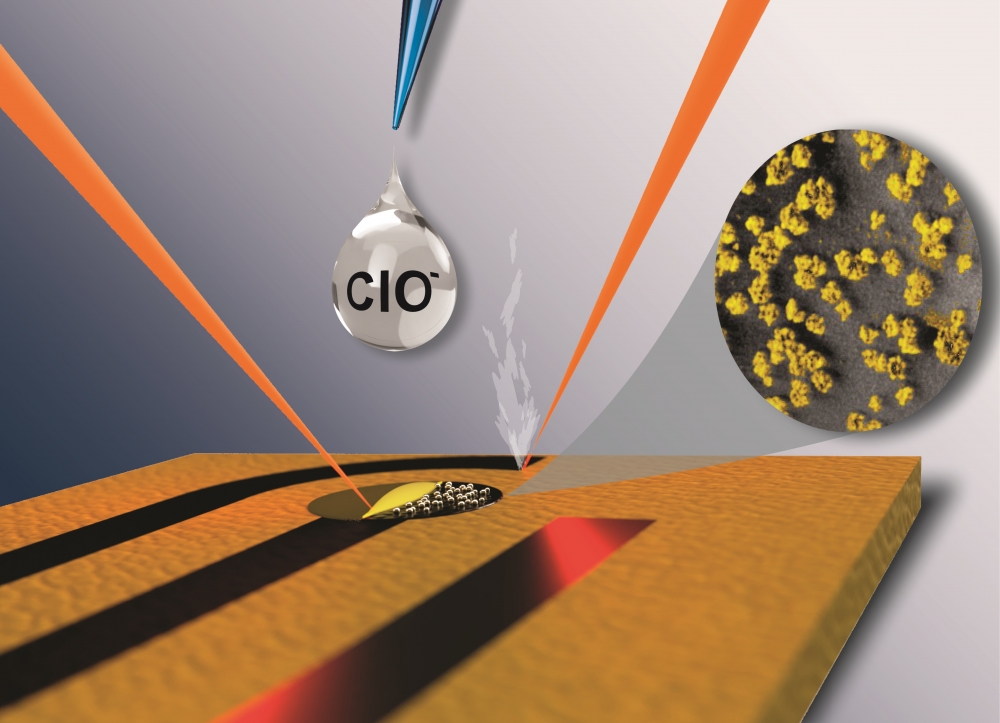

Illustration: Gabriel N. Meloni
The device developed at the University of São Paulo is inexpensive, environmentally friendly and easy to use. A patent application has been filed.
By Julia Moióli | Agência FAPESP – A portable sensor made of paper and laser-synthesized gold nanoparticles has been developed in Brazil by researchers at the University of São Paulo (USP) to facilitate and lower the cost of producing devices for out-of-laboratory identification of chemical compounds present in liquids, including contaminants of drinking water. The results of the study are highlighted by the United Kingdom’s Royal Society of Chemistry in its account on X, the social media platform, and detailed in an article published in the journal Sensors & Diagnostics.
Costing just over BRL 0.50 (about USD 0.09), the sensor is disposable and can be mass-produced anywhere in the world without human intervention, a major challenge for sensor fabrication. The authors have filed for a patent on the technology.
“We successfully used laser synthesis to fabricate the nanoparticles and remove the need for human manipulation, which raises the cost. This makes large-scale production possible,” said Thiago Regis Longo Cesar da Paixão, full professor at USP and head of the Electronic Tongue and Chemical Sensor Laboratory at the Institute of Chemistry (IQ-USP). “The laser carbonizes the surface of the paper, converting cellulose into carbon, and with a single drop of gold solution, the nanomaterial forms on the surface.”
The gold nanoparticles on the paper substrate are responsible for an electrochemical reaction that identifies substances present in the liquid. According to Paixão, they also considerably enhance the sensor’s performance compared with devices fabricated using screen printing, inkjet printing, sputtering or pencil drawing, among others, as they assure greater specificity in distinguishing chemical species originating in the same environment.
Another advantage of the device is its sustainability. Being kraft paper-based, it can include reused or underused material. No toxic chemicals are used, in contrast with the procedures followed to make most sensors.
Multiple applications
The study, which was funded by FAPESP, showed that the sensor performed as well as costlier devices in detecting hypochlorite, used to treat drinking water and swimming pools (as well as being present in household bleach), but harmful in large quantities.
According to Paixão, however, the sensor is highly versatile and can be used to monitor other chemicals of interest in healthcare, where it can facilitate diagnosis, and in environmental management, where it can identify pollutants, for example.
“It’s easy to use and could be widely distributed by government to let people monitor water quality in their own homes. The data could be passed on to specialists, who could map the results to help policymakers improve water quality management,” Paixão said.
Two fronts
Next steps for the scientists will include combining the two research fronts – synthesis of nanomaterials and 3D printing – in order to increase the advantages of this type of sensor and apply for a patent.
“We want to create a device for the kinds of analysis performed by the public health system, such as measuring blood sugar levels, or that can be used by big techs like Google, Microsoft and Samsung in wearable sensors for real-time monitoring,” Paixão said.
The other co-authors of the article are Helton P. Nogueira, Iana Vitória Spadini Arantes, Jéssica S. G. Selva, Juliana L. M. Gongoni, Mauro Bertotti, Vanessa Neiva de Ataide and Wilson Akira Ameku, all of whom are also affiliated with IQ-USP.
The article “Laser-induced fabrication of gold nanoparticles onto paper substrates and their application on paper-based electroanalytical devices” is at: pubs.rsc.org/en/content/articlelanding/2023/SD/D2SD00176D.
Republish
The Agency FAPESP licenses news via Creative Commons (CC-BY-NC-ND) so that they can be republished free of charge and in a simple way by other digital or printed vehicles. Agência FAPESP must be credited as the source of the content being republished and the name of the reporter (if any) must be attributed. Using the HMTL button below allows compliance with these rules, detailed in Digital Republishing Policy FAPESP.






